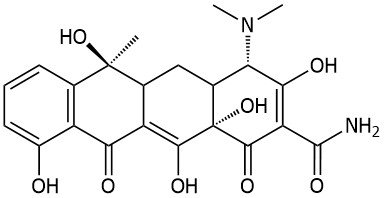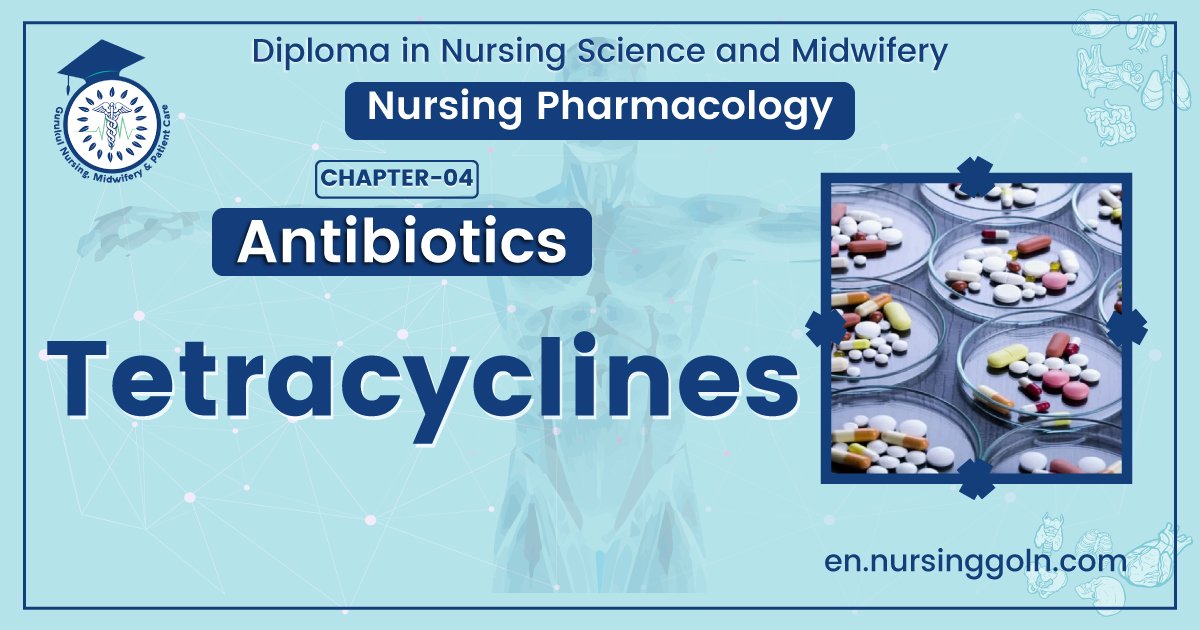Concept of Tetracyclines – This book covers the entire syllabus of “Pharmacology” prescribed by BNMC- for a diploma in nursing science & midwifery students. We tried to accommodate the latest information and topics. This book is an examination set up according to the teachers’ lectures and examination questions.
At the end of the book, previous questions are given. We hope in touch with the book students’ knowledge will be upgraded and flourish. The unique way of presentation may make your reading of the book a pleasurable experience.

Concept of Tetracyclines
Tetracyclines consist of four fused rings with a system of conjugated double bonds. Substitutions on these rings alter the individual pharmacokinetics and spectrum of antimicrobial activity.
Source & history
Tetracycline: Discovered in 1953 obtained by the catalytic dehalogenation of chlortetracycline.
Chemical structure
Tetracyclines are closely congeneric derivative of the polycyclic naphthacene-carboxamide. Structural formula of tetracycline –

Mechanism of action
Tetracy-clines enter susceptible organisms via passive diffusion and also by an energy- dependent transport protein mechanism
↓
Tetracy-clines concentrate intracellularly in susceptible organisms.
↓
The drugs bind reversibly to the 30S subunit of the bacterial ribosome.
↓
This action prevents binding of tRNA to the mRNA-ribosome complex
↓
Inhibiting bacterial protein synthesis
Pharmacokinetics of tetracycline:
1. Routes of administration: oral, parenteral and topical.
2. Absorption: Incomplete, irregular from the gut.
3. Distribution; Widely distributed:
➤ Most fluid compartments
➤ Can cross the placenta
➤ Appears in milk.
4. Excretion: By two routes
➤ Renal route
➤ Non-renal (faeces, bile) (Doxycycline)
5. Plasma half-life:
➤ Tetracycline: 6 hours
➤Doxycycline: 16 hours
➤ Minocycline: 15 hours
Antibacterial spectrum
The tetracy-clines are bacteriostatic antibiotics effective against a wide variety of organisms, including gram-positive and gram-negative bacteria, protozoa, spirochetes, mycobacteria, and atypical species.
Major uses/ indication of tetracycline.
Uses
Although tetracy-clines are broad-spectrum antibiotics, they should be employed only for those infections for which a more selective and less toxic AMA is not available. Clinical use of tetracy-clines has very much declined due to availability of fluoroquinolones and other efficacious AMAS.
Empirical therapy
Tetracyclines are often employed when the nature and sensitivity of the infecting organism cannot be reasonably guessed. However, they are not dependable for empirical treatment of serious/life-threatening infections.
A. Tetracyclines are the first-choice drugs
1. Venereal diseases:
➤ Chlamydial nonspecific urethritis/endocervicitis: 7 day doxycycline treatment is as effective as azithromycin single dose.
➤ Lymphogranuloma venereum: resolves in 2-3 weeks.
➤ Granuloma inguinale: due to Calymm. granulomatis: a tetracycline administered for 3 weeks is the most effective treatment.
2. Atypical pneumonia: due to Mycoplasma pneumoniae
3. Cholera: Tetracyclines have adjuvant value by reducing stool volume and limiting the duration of diarrhoea.
4. Brucellosis: Tetracyclines are highly efficacious; cause rapid symptomatic relief3
5. Plague: Tetracyclines are highly effective in both bubonic and pneumonic plague.
6. Relapsing fever: due to Borrelia recurrentis responds adequately.
7. Rickettsial infections:
➤ typhus,
➤rocky mountain spotted fever,
➤ Q fever
B. Tetracyclines are second choice drugs:
1. To penicillin/ampicillin for tetanus, anthrax, actinomycosis and Listeria infections.
2. To ceftriaxone, amoxicillin or azithromycin for gonorrhea.
C. Other situations in which tetracyclines may be used are:
1. Urinary tract infections: Odd cases in which the organism has been found sensitive.
2. Community-acquired pneumonia, when a more selective antibiotic cannot be used.
3. Amoebiasis: along with other amoebicides for chronic intestinal amoebiasis.
4. As adjuvant to quinine or artesunate for chloroquine-resistant P. falciparum malaria
5. Acne vulgaris
6. Chronic obstructive lung disease: prophylactic use may reduce the frequency of exacerbations, but the risk: benefit ratio is controversial.

Adverse effects of tetracycline
A. Hypersensitivity (susceptible patient)
➤ Skin rash
➤ Urticaria
➤ Dermatitis
➤ Drug fever
B. On teeth
➤Yellow brown discoloration
➤ Enamel dysplasia
➤ Dental carries
➤ Deformities
C. On kidney
➤ Fanconi’s syndrome Nephrogenic diabetes insipidus
➤ Renal damage
D. On bones
➤ Deformities
➤ Growth retardation
E. GIT effects
➤ Nausea
➤ Vomitingabe
➤ Irritation
➤ Vitamin B deficiency
➤ Enterocolitis
➤ Anal pruritis
➤ Fatty change of liver and
➤ Jaundice
F. Others
➤ Thrombophlebitis
➤ Photosensitivity (systemic tetracycline: Demeclocycline)

Contraindication of tetracycline
1. Children under age of 8 years.
2. Pregnancy:
➤ Early: Teratogenicity
➤ Late: Foetal bone deformity
3. Hepatotoxicity
4. Discoloration of the teeth of offspring
5. Nursing mother.
6. Established renal failure (doxycycline can be used)
7. History of hypersensitivity to tetracycline.
8. Systemic lupus erythematosus (SLE)
Resistance
The most commonly encountered naturally occurring resistance to tetracyclines is an efflux pump that expels drug out of the cell, thus preventing intracellular accumulation. Other mechanisms of bacterial resistance to tetracyclines include enzymatic inactivation of the drug and production of bacterial proteins that prevent tetracyclines from binding to the ribosome. Resistance to one tetracycline does not confer universal resistance to all tetracyclines.
Drugs interactions:
A. Tetracycline + Antacids/milk Decrease absorption of tetracycline due to chelating effect so decrease effectiveness of tetracycline.
B. Tetracycline + Iron-Reduce absorption of tetracyclines.
Fanconi’s Syndrome.
Fanconi’s Syndrome
It occurs due to ingestion of outdated and degraded tetracycline, which is characterized by:
➤ Nausea. vomiting
➤ Polyuria, polydipsia, proteinuria
➤ Acidosis. glycosuria
➤ Gross amino-acidurianta
➤ Facial lesion.
This is called Fanconi’s syndrome.
This is because of toxic effects on proximal renal tubular outdated tetracycline preparations cause nitrogen retention and thus produce renal tubular acidosis and other renal injury. Treatment by stomach wash.
Read more:
